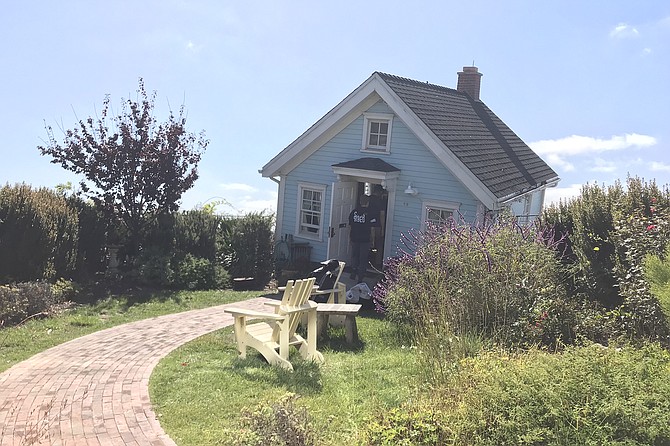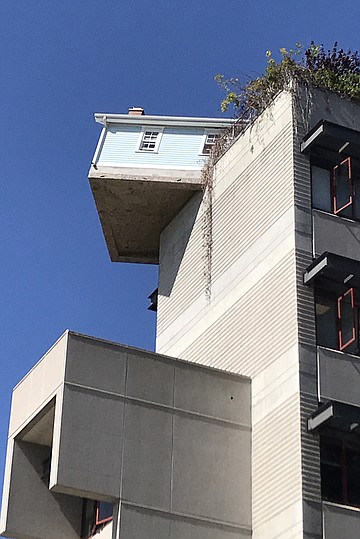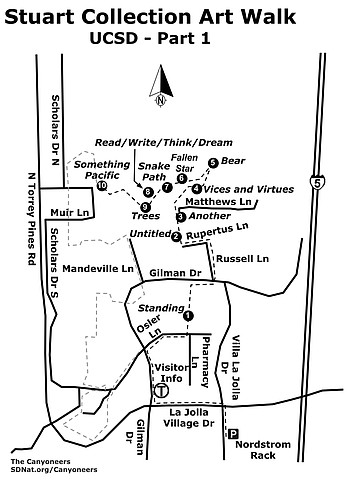 Facebook
Facebook
 X
X
 Instagram
Instagram
 TikTok
TikTok
 Youtube
Youtube

One of the more intriguing walks in San Diego is on the University of California San Diego campus, where commissioned sculptures are integrated into site-specific works that may be tricky to find. The collection, named for its first benefactor, James Stuart DeSilva, is a partnership that began in 1982 between the Stuart Collection and the university. Some of the public art projects are integrated into university buildings. Funding for the artistic creations comes from the Stuart Foundation, Friends of the Stuart Collection, the National Endowment for the Arts, and various organizations. UCSD’s Department of Visual Arts also provides enthusiastic support. The Stuart Collection Advisory Board recommends artists for commission. Currently, 20 art projects are on display, with a 21st in the planning stages.
The Commuter & Visitor Information building on Gilman Drive has maps showing the general location of the sculptures, but the map does not give the exact details as to their location, size, or specific nature. It is easy to add more mileage to this walk in the search for all of them. The university map does list the artist’s name and the name of the artwork. More details can be found at the Stuart Collection website: stuartcollection.ucsd.edu.

The route described here begins and ends at the Visitor Information building and travels in a counter-clockwise meandering circle. It is 0.5 mile from the La Jolla Village parking area to the Information building on Gilman Drive where the actual walk begins. The campus map lists the works in the order of when they were commissioned, not the order in which you will see them. Follow these instructions to not miss any of them. The sculpture numbers, as you will see them, are listed after the mileage in the text and on the map.
From the information building on Gilman Drive, begin walking north on the dirt path that turns right onto Osler Lane. At Pharmacy Lane, turn left (north) and look for the first sculpture directly east of the School of Medicine, entitled Standing by artist Kiki Smith, at mile 0.2 (1). Standing on top of a eucalyptus trunk, this beautiful sculpture of a woman evokes the strength and frailty of the human body and the power and limits of modern medicine. Note the nails in the breast of the sculpture, symbolizing eastern medicine meeting western medicine, as in acupuncture.
Continue north on the walkway toward Gilman Drive, passing under a walkway between buildings on the right and then turning right to join Gilman Drive. Take the crosswalk heading left (north) on Russell Lane, passing the Gilman parking structure. Turn left on Rupertus, walking west to the end of the street and the grassy area just west of the Student Service Center at mile 0.6 (2) where there is a water fountain counterposed to the American flag on a pole and a monument to Camp Matthews, which was located on this site during World War II. The functional water fountain, named Untitled by artist Michael Asher, represents the banal administrative environment and the continuity and contradiction of the military and the university. It also calls attention to the ongoing water crisis of Southern California.
Walk past the fountain, taking a quick right (east) and walk toward the Price Center and up the steps to enter the Price Center East’s atrium, where the third sculpture is found integrated into a wall—two massive clocks, at mile 0.7 (3), called Another by artist Barbara Kruger. One clock shows the time with Roman numerals and the other with digit numerals. LED displays give live current events. On the clocks are scattered word phrases: ANOTHER DAY, ANOTHER EXAM, ANOTHER FEAR, ANOTHER LOVE, ANOTHER LIFE, ANOTHER JOB, and so forth. This work represents the moments, events, and objects that comprise our lives.
Exit the Price Center and continue walking east and then turn north, crossing Matthews Lane. Look at the top of the building on your left, which is the Charles Lee Powell Structural Systems Laboratory, at mile 0.9 (4), where artist Bruce Nauman has installed his Vices and Virtues. Neon words flash at the top on each side of the building denoting seven contradictions. They circulate around the building at various speeds — FAITH/LUST, HOPE/ENVY, FORTITUDE/ANGER, CHARITY/SLOTH, JUSTICE/AVARICE, TEMPERANCE/GLUTTONY, and PRUDENCE/PRIDE — denoting how these opposites are never really separate entities.
The next sculpture is hard to miss. It is a giant 23-foot bear weighing 180 tons by artist Tim Hawkinson. Walk across Warren College plaza and look left between two buildings to see the sculpture entitled Bear at mile 1.0 (5). This massive creature consists of eight large granite rocks, pushing the limits of incredibility; it is considered an engineering feat. After viewing Bear, backtrack to the plaza and walk east toward the Geisel Library, looking up when you reach Jacobs Hall at mile 1.1 (6). You will see a small house hanging on the edge of the roof, entitled Fallen Star by artist Do Ho Suh. If you take the elevator to the 7th floor, you can look out toward the house though a locked glass door. On Tuesdays and Thursdays the door is open when representatives from the Stuart Collection are there between 11 a.m. and 2 p.m., showing the inside of the house. The house represents home and cultural displacement, and it is a challenge to stand up straight on the leaning floors.
Continue past Jacobs Hall to the walkway leading to the Geisel Library. Note the colored slate pattern on the walkway, entitled Snake Path by artist Alexis Smith. The head of the snake points toward the library entrance at mile 1.2 (7). Walk down stairs to view the library entrance, which is the next sculpture at mile 1.3 (8) entitled Read/Write/Think/Dream by artist John Baldessari, consisting of eight 10-foot high glass panels depicting students atop rows of books.
After viewing the entrance, head a short distance south, still at mile 1.3 (9), to see the first of two metal Trees by artist Terry Allen, depicting nature and displacement. As the campus has grown, there has been a continual loss of natural environment. The artist took two eucalyptus trees that had been cut down and encased them in metal for this work.
Turn right (west) to see the second tree and then right again along a pathway leading to a building on the left with a mural of a doll on a wall. Between the buildings is a stairway leading to a street. Walk up the steps and turn right. Ahead you will see the Communications building. In front of the building to your right is a very small sculpture in a grassy area, easy to miss. It is a small person watching a television screen, at mile 1.5 (10), and it relates directly to its site – the university’s Media Center. It is entitled Something Pacific by artist Nam June Paik. Look for other televisions embedded in the landscape and other works by this artist in the lobby of the Media Center.
See Part 2 of the Stuart Collection walk in next week’s Roam-O-Rama column to complete this unusual trek.

STUART COLLECTION ART WALK (UCSD) – Part 1
This walk is a treasure hunt for unusual works of art by leading artists.


One of the more intriguing walks in San Diego is on the University of California San Diego campus, where commissioned sculptures are integrated into site-specific works that may be tricky to find. The collection, named for its first benefactor, James Stuart DeSilva, is a partnership that began in 1982 between the Stuart Collection and the university. Some of the public art projects are integrated into university buildings. Funding for the artistic creations comes from the Stuart Foundation, Friends of the Stuart Collection, the National Endowment for the Arts, and various organizations. UCSD’s Department of Visual Arts also provides enthusiastic support. The Stuart Collection Advisory Board recommends artists for commission. Currently, 20 art projects are on display, with a 21st in the planning stages.
The Commuter & Visitor Information building on Gilman Drive has maps showing the general location of the sculptures, but the map does not give the exact details as to their location, size, or specific nature. It is easy to add more mileage to this walk in the search for all of them. The university map does list the artist’s name and the name of the artwork. More details can be found at the Stuart Collection website: stuartcollection.ucsd.edu.

The route described here begins and ends at the Visitor Information building and travels in a counter-clockwise meandering circle. It is 0.5 mile from the La Jolla Village parking area to the Information building on Gilman Drive where the actual walk begins. The campus map lists the works in the order of when they were commissioned, not the order in which you will see them. Follow these instructions to not miss any of them. The sculpture numbers, as you will see them, are listed after the mileage in the text and on the map.
From the information building on Gilman Drive, begin walking north on the dirt path that turns right onto Osler Lane. At Pharmacy Lane, turn left (north) and look for the first sculpture directly east of the School of Medicine, entitled Standing by artist Kiki Smith, at mile 0.2 (1). Standing on top of a eucalyptus trunk, this beautiful sculpture of a woman evokes the strength and frailty of the human body and the power and limits of modern medicine. Note the nails in the breast of the sculpture, symbolizing eastern medicine meeting western medicine, as in acupuncture.
Continue north on the walkway toward Gilman Drive, passing under a walkway between buildings on the right and then turning right to join Gilman Drive. Take the crosswalk heading left (north) on Russell Lane, passing the Gilman parking structure. Turn left on Rupertus, walking west to the end of the street and the grassy area just west of the Student Service Center at mile 0.6 (2) where there is a water fountain counterposed to the American flag on a pole and a monument to Camp Matthews, which was located on this site during World War II. The functional water fountain, named Untitled by artist Michael Asher, represents the banal administrative environment and the continuity and contradiction of the military and the university. It also calls attention to the ongoing water crisis of Southern California.
Walk past the fountain, taking a quick right (east) and walk toward the Price Center and up the steps to enter the Price Center East’s atrium, where the third sculpture is found integrated into a wall—two massive clocks, at mile 0.7 (3), called Another by artist Barbara Kruger. One clock shows the time with Roman numerals and the other with digit numerals. LED displays give live current events. On the clocks are scattered word phrases: ANOTHER DAY, ANOTHER EXAM, ANOTHER FEAR, ANOTHER LOVE, ANOTHER LIFE, ANOTHER JOB, and so forth. This work represents the moments, events, and objects that comprise our lives.
Exit the Price Center and continue walking east and then turn north, crossing Matthews Lane. Look at the top of the building on your left, which is the Charles Lee Powell Structural Systems Laboratory, at mile 0.9 (4), where artist Bruce Nauman has installed his Vices and Virtues. Neon words flash at the top on each side of the building denoting seven contradictions. They circulate around the building at various speeds — FAITH/LUST, HOPE/ENVY, FORTITUDE/ANGER, CHARITY/SLOTH, JUSTICE/AVARICE, TEMPERANCE/GLUTTONY, and PRUDENCE/PRIDE — denoting how these opposites are never really separate entities.
The next sculpture is hard to miss. It is a giant 23-foot bear weighing 180 tons by artist Tim Hawkinson. Walk across Warren College plaza and look left between two buildings to see the sculpture entitled Bear at mile 1.0 (5). This massive creature consists of eight large granite rocks, pushing the limits of incredibility; it is considered an engineering feat. After viewing Bear, backtrack to the plaza and walk east toward the Geisel Library, looking up when you reach Jacobs Hall at mile 1.1 (6). You will see a small house hanging on the edge of the roof, entitled Fallen Star by artist Do Ho Suh. If you take the elevator to the 7th floor, you can look out toward the house though a locked glass door. On Tuesdays and Thursdays the door is open when representatives from the Stuart Collection are there between 11 a.m. and 2 p.m., showing the inside of the house. The house represents home and cultural displacement, and it is a challenge to stand up straight on the leaning floors.
Continue past Jacobs Hall to the walkway leading to the Geisel Library. Note the colored slate pattern on the walkway, entitled Snake Path by artist Alexis Smith. The head of the snake points toward the library entrance at mile 1.2 (7). Walk down stairs to view the library entrance, which is the next sculpture at mile 1.3 (8) entitled Read/Write/Think/Dream by artist John Baldessari, consisting of eight 10-foot high glass panels depicting students atop rows of books.
After viewing the entrance, head a short distance south, still at mile 1.3 (9), to see the first of two metal Trees by artist Terry Allen, depicting nature and displacement. As the campus has grown, there has been a continual loss of natural environment. The artist took two eucalyptus trees that had been cut down and encased them in metal for this work.
Turn right (west) to see the second tree and then right again along a pathway leading to a building on the left with a mural of a doll on a wall. Between the buildings is a stairway leading to a street. Walk up the steps and turn right. Ahead you will see the Communications building. In front of the building to your right is a very small sculpture in a grassy area, easy to miss. It is a small person watching a television screen, at mile 1.5 (10), and it relates directly to its site – the university’s Media Center. It is entitled Something Pacific by artist Nam June Paik. Look for other televisions embedded in the landscape and other works by this artist in the lobby of the Media Center.
See Part 2 of the Stuart Collection walk in next week’s Roam-O-Rama column to complete this unusual trek.

STUART COLLECTION ART WALK (UCSD) – Part 1
This walk is a treasure hunt for unusual works of art by leading artists.